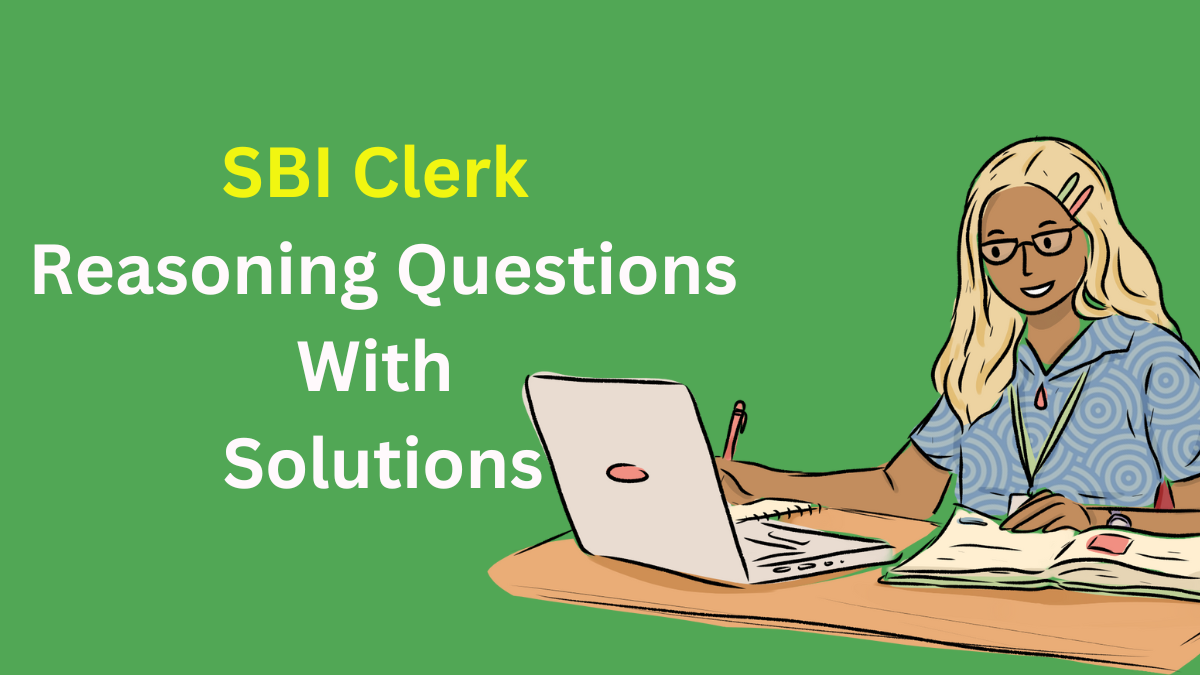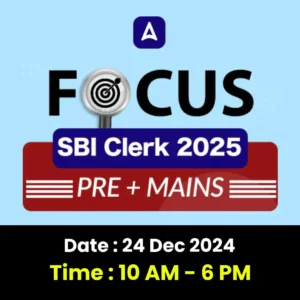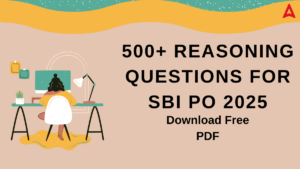The SBI Clerk Exam is one of the most competitive banking exams in India, attracting aspirants looking to build a career in the banking sector. The Reasoning Ability section plays a crucial role in assessing a candidate’s logical thinking, analytical skills, and problem-solving abilities. There are many clerical exams lineup in the banking sector with SBI Clerk Exam 2025, mastering this section is essential to boost your overall performance and achieve a strong score.
The reasoning section in the SBI Clerk exam typically includes various types of questions. Here are some of the most common types:
- Puzzles
- Seating Arrangement
- Syllogism
- Blood Relations
- Inequalities
- Coding-Decoding
- Direction Sense
- Order and Ranking
- Data Sufficiency
SBI Clerk Reasoning Questions
Directions (1-5): Study the following sequence carefully and answer the questions given below.
H @ T R $ D % E J ^ K & L A * N π B V £ C © O Z µ X ¥ W α € U P Ω M ∞ I
Q1. How many meaningful words can be formed if each letter is used once by using the 3rd, 8th and 16th elements from the left end?
(a) None
(b) One
(c) Two
(d) Three
(e) None of these
Q2. What is the position of ‘&’ with respect to the one which is to the immediate left of ‘W’ in the given series?
(a) Fifteenth to the left
(b) Sixteenth to the left
(c) Fourteenth to the left
(d) Seventeenth to the left
(e) None of these
Q3. How many letters are there which are immediately preceded by and immediately followed by a symbol?
(a) Eight
(b) Seven
(c) Six
(d) Nine
(e) None of these
Q4. Which amongst the following element is 9th to the left of 12th element from the right end?
(a) π
(b) B
(c) *
(d) N
(e) None of these
Q5. How many vowels are there which are immediately preceded by a symbol and immediately followed by a consonant?
(a) Two
(b) Four
(c) Three
(d) One
(e) None of these
Directions (6-10): Answer the questions based on the information given below:
Seven persons A, B, C, D, E, F, and G are sitting around a circular table facing towards the centre. There is one vacant seat on the table. Each of them likes different fruits among apple, guava, mango, banana, kiwi, litchi, and grapes but not necessarily in the same order.
Two persons are sitting between the one who likes Kiwi and E who is not sitting adjacent to the vacant seat. The seat of the one who likes Banana is third to the right of B. B is an immediate neighbour of neither E nor the one who likes Kiwi. E likes neither Banana nor Apple. D is sitting adjacent to the vacant seat. A sits on second seat to the right of G who does not like Banana. The one who likes Apple sits on second seat to the right of the one who likes Grapes. B does not like Guava. D likes mango and sits on the seat third to the left of F.
Note: If ‘n’ persons are sitting between two persons, then there may be ‘n’ or ‘n+1’ seats between them.
Q6. Who among the following likes Banana?
(a) C
(b) F
(c) B
(d) A
(e) None of the above
Q7. How many persons are sitting between C and D when counted from the left of C?
(a) None
(b) One
(c) Three
(d) Two
(e) None of the above
Q8. Who sits opposite to A?
(a) The one who likes Litchi
(b) The one who likes Guava
(c) The one who likes Apple
(d) The one who likes Kiwi
(e) None of the above
Q9. G likes which of the following fruits?
(a) Grapes
(b) Guava
(c) Apple
(d) Kiwi
(e) None of the above
Q10. How many persons are sitting between F and the person who likes Guava when counted from the right of F?
(a) None
(b) One
(c) Three
(d) Two
(e) None of the above
Directions (11-15): Answer the questions based on the information given below.
Seven students (P, Q, R, S, T, U and V) take different examination (CAT, CGL, CHSL, Clerk, MAT, MTS and PO) on 1st of seven different months (March, April, May, June, July, August and September) in the same year. All the information is not used in the same manner as given.
V takes Clerk exam in the month which has 31 days. The one who takes MAT exam takes after the one who takes Clerk exam. One student takes exam between V and T who takes CHSL exam in the month having 30 days. Neither S nor R takes CAT exam. U takes PO exam just before the one who takes CGL exam. Student who takes CAT exam takes three months before T. The one who takes MTS exam doesn’t take just after or just before T. S takes exam four months before Q.
Q11. Who among the following takes MTS exam in the month of May?
(a) Q
(b) R
(c) P
(d) S
(e) None of these
Q12. Who takes exam in the month of July?
(a) Q
(b) R
(c) P
(d) V
(e) None of these
Q13. Who takes exam two months before Q?
(a) The one who takes CGL exam
(b) The one who takes MTS exam
(c) The one who takes MAT exam
(d) The one who takes CAT exam
(e) None of these
Q14. Four from the following are similar in a certain way and forms a group. Find out the one who does not belong to that group.
(a) U
(b) R
(c) Q
(d) V
(e) P
Q15. How many students take exam before P?
(a) Three
(b) Two
(c) Zero
(d) Four
(e) None of these
Directions (16-20): A word arrangement machine when given an input of words, rearranges the words following a particular set of rules. An illustration of that is given below.
Input: RAM TYU GTR WTI VFD DGH
Step I: DGH GTR RAM TYU VFD WTI
Step II: DGH GRT AMR TUY DFV ITW
Step III: EHI HSU ZNS UTZ EGW HUX
Step IV: ZNS UTZ HUX HSU EHI EGW
Step V: NSZ TUZ HUX HSU EHI EGW
Step V is the last step of the rearrangement. Following the same set of rules rearrange the input given below and answer the questions based on it.
Input: PQU GRB UTV XQJ WYK SHD
Q16. Which of the following is the last step of the given input?
(a) TUW QRT LXZ KRY EIT CHS
(b) TUW LXZ QRT KRY EIT CHS
(c) TUW QRT LXZ EIT KRY CHS
(d) TUW LXZ QRT KRY CHS EIT
(e) None of these
Q17. Which word is the third from the right end in step III of the given input?
(a) EIT
(b) UTW
(c) QRT
(d) LXZ
(e) None of these
Q18. In which step ‘QRT EIT UTW’ will be found in the same sequence?
(a) Step II
(b) Step IV
(c) Step III
(d) Step V
(e) None of these
Q19. What is the position of ‘QRT’ from right end in the step IV of the given input?
(a) First
(b) Fourth
(c) Fifth
(d) Second
(e) None of these
Q20. Which of the following is the second last step of the given input?
(a) UTW QRT LXZ KRY EIT CHS
(b) TUW QRT LXZ KRY EIT CHS
(c) TUW LXZ QRT KRY CHS EIT
(d) UTW QRT LXZ EIT KRY CHS
(e) None of these
Directions (21-25): The question consists of two statements numbered I and II given below it. You have to decide whether the data provided in the statement is sufficient to answer the question.
Q21. Six boxes, P, Q, R, S, T and U are placed one above another, where the bottommost box is 1, the box above it is 2 and so on up to 6 which is placed at the topmost position. Which box ix placed just above R?
Statements: I. P is placed 2nd above of T which is placed just above of Q. Two boxes are placed between T and U.
- S is placed above P. R is not placed at the even numbered position.
(a) Data given in both statements I and II together are sufficient to answer.
(b) Data given in statement I alone is sufficient to answer.
(c) Data given in statement II alone is sufficient to answer.
(d) Data given in both statements I and II together are not sufficient to answer.
(e) Data given in either statement I or statement II alone is sufficient to answer the question.
Q22. There are six persons namely, A to F of different ages. Who is the oldest person?
Statements: I. E is older than A who is older than C. F is younger than D.
- D is older than E. B is not the oldest person.
(a) Data given in both statements I and II together are sufficient to answer.
(b) Data given in statement I alone is sufficient to answer.
(c) Data given in statement II alone is sufficient to answer.
(d) Data given in both statements I and II together are not sufficient to answer.
(e) Data given in either statement I or statement II alone is sufficient to answer the question.
Q23. Who sits second to the right of F if A, B, C, D, E and F are sitting in a straight row facing north but not necessarily in the same order?
Statements: I. Three persons sit between A and F who sits at the extreme left end of the row. A sits second to the right of E.
- B sits third to the right of F who sits second to the right of A. Three persons sit between A and E.
(a) Data given in both statements I and II together are sufficient to answer.
(b) Data given in statement I alone is sufficient to answer.
(c) Data given in statement II alone is sufficient to answer.
(d) Data given in both statements I and II together are not sufficient to answer.
(e) Data given in either statement I alone or statement II alone is sufficient to answer the question.
Q24. Eight persons A, B, C, D, E, F, G, and H are sitting along a circular table facing towards the center of the table but not necessarily in the same order. Who sits second to the right of A?
Statements: I. Three persons sit between A and F who sits second to the left of E.
- B sits third to the right of F who sits second to the right of C.
(a) Data given in both statements I and II together are sufficient to answer.
(b) Data given in statement I alone is sufficient to answer.
(c) Data given in statement II alone is sufficient to answer.
(d) Data given in both statements I and II together are not sufficient to answer.
(e) Data given in either statement I alone or statement II alone is sufficient to answer the question.
Q25. Eight persons P, Q, R, S, T, U, V, and W are sitting around a circular table facing the center. Who sits to the immediate right of W?
Statements: I. P sits third to the right of U. W sits second to the right of P.
- R does not sit adjacent to S.
(a) Data given in both statements I and II together are sufficient to answer.
(b) Data given in statement I alone is sufficient to answer.
(c) Data given in statement II alone is sufficient to answer.
(d) Data given in both statements I and II together are not sufficient to answer.
(e) Data given in either statement I alone or statement II alone is sufficient to answer the question.
Directions (26-30): Study the following information carefully and answer the questions accordingly.
Eight people P, Q, R, S, T, U, V, and W are sitting around a circular table facing outside. Each one of them has a different number of books i.e., 10, 25, 33, 42, 49, 55, 61, and 66 but not necessarily in the same order.
Two people are sitting between S who is not an immediate neighbor of Q and the one who has 33 books. U is sitting immediate right of the one who has 33 books. Two people are sitting between the one who has a square number of books i.e., less than 42 and U. At most two people are sitting between the one who has a square number of books i.e., less than 42 and the one who has 33 books. The one who has the least number of books sits third to the right of Q who does not have 33 or 25 books. S does not have the least number of books. P who does not have 25 books sits immediate right of R who does not have the least number of books. T has an even number of books. The difference between T’s and V’s books is more than 15. At least one person is sitting between P and W. R has a square number of books. Q has an even number of books and more books than R has. P’s immediate neighbour has an even number of books. U has more books than P has.
Q26. Who has the least number of books?
(a) S
(b) W
(c) R
(d) T
(e) None of these
Q27. How many people sit between V and the one who has 42 books from the right of V?
(a) Four
(b) Five
(c) Two
(d) Six
(e) None of these
Q28. What is the position of U from the one who has the maximum number of books?
(a) Second to the right
(b) Third to the left
(c) Fourth to the left
(d) Immediate right
(e) None of these
Q29. Four from the following are similar in a certain way and forms a group. Find out the one who does not belong to that group.
(a) V
(b) R
(c) W
(d) T
(e) P
Q30. Who is sitting third to the right of R?
(a) V
(b) The one, who has 42 books
(c) Q
(d) The one who has 25 books
(e) None of these
Directions (31-33): In the following questions, the symbols &, @, *, $, % and © are used with the following meanings as illustrated below. Study the following information and answer the given questions:
P@Q- P is the child of Q
P©Q- P is the parent of Q
P%Q- P is father-in-law of Q
P&Q- P is brother-in-law of Q
P$Q- P is brother of Q
P*Q- P is wife of Q
Q31. If the expression ‘A@D©B$E*G’ is true, then how G is related to D?
(a) Father-in-law
(b) Brother
(c) Son
(d) Son-in-law
(e) Cannot be determined
Q32. If the expression ‘L*M&T@R*S©L’ is true, then which of the following is true?
(a) L is son of R
(b) R is mother-in-law of M
(c) T is daughter of S
(d) S is mother-in-law of M
(e) None is true
Q33. If the expression ‘K$N©T@O%M©U’ is true, the which of the following is not true? (O has only one daughter).
(a) U is grandchild of O
(b) K is uncle of T
(c) M is mother of U
(d) N is grandmother of U
(e) All are true
Q34. If in the number 472561839, 2 is multiply to each of the digit which is less than five and 2 is subtracted from each of the digit which is greater than four then all digits are arranged in ascending order from left to right. What is the resultant of the multiplication of the digit which is third from the left end and the digit which is fourth from the right end in new arrangement?
(a) 12
(b) 24
(c) 32
(d) 20
(e) 27
Q35. If all the vowels of the word ‘SURVEILLANCE’ are replaced by its succeeding letter according to the English alphabet and all the consonant are replaced with their previous letter according to the English alphabet and then all the letters are arranged in the alphabetical order the how many letters are there between the third letter from the left and fourth letter from the right in the English alphabetic series?
(a) 5
(b) 12
(c) 11
(d)10
(e) 9
Directions (36-40): Answer the questions based on the information given below.
Seven persons A, B, C, D, E, F and G study in seven different universities namely JNU, JMI, IIT, BHU, DU, SNU and IGNOU but not in the same order. Each person likes different subjects viz. Civics, History, English, Geography, Chemistry, Physics and Biology but again not in the same order.
F likes Civics and studies neither in JMI nor in SNU. The one who studies in IGNOU, likes History. A studies in JNU and likes neither Geography nor Chemistry. The one who studies in DU likes Biology. B likes Physics and does not study in SNU. The one who studies in SNU does not like Chemistry. D studies in IIT University. G does not like History and does not study in SNU University. E does not study in SNU.
Q36. Who among the following studies in IGNOU University?
(a) The one who likes English
(b) B
(c) The one who likes History
(d) G
(e) None of these
Q37. Who among the following likes Chemistry?
(a) The one who studies in JMI
(b) A
(c) The one who studies in JNU
(d) The one who studies in IIT
(e) None of these
Q38. C studies in which of the following University?
(a) JNU
(b) SNU
(c) DU
(d) JMI
(e) None of these
Q39. Which of the following statement is correct about the one who likes English?
(a) The one who likes English, studies in IIT
(b) F likes English
(c) The one who likes English, studies in JNU
(d) E likes English
(e) None of these
Q40. Four from the following are similar in a certain way and forms a group. Find out the one, which does not belong to that group.
(a) A – JMI
(b) C -IIT
(c) D – IGNOU
(d) F – DU
(e) G – DU
Directions (41-45): Answer the questions based on the information given below.
Nine persons A, B, C, D, E, F, G, H and I were born in nine consecutive years from 1988 to 1996. Each of them joined MNC with different salaries viz 21K, 25K, 26K, 27K, 28K, 29K, 30K, 32K and 33K but not in the same order. (K is constant)
I was born immediately before D. The person who was born in 1994, joined MNC with 32K salary. Two persons were born between C and I. No one was born between H and the one who has 21K salary. H was born before the one who has 27K salary. G joined MNC with 30K salary. I and B joined the MNC at consecutive salaries. I doesn’t join in the prime numbered salary. F was born after the one who joined with 25K salary, but F did not join with 26K salary. B was born immediately after the one who joined with 26K salary. G was born in 1991. The one who joined with 26k was born after G but not immediately after him. The one who joined with 25K salary was born immediately before G. A was born in 1988 and joined MNC with 21K salary. F was not born in leap year. Difference between the salary of H and B is 4k.
Q41. Who among the following was born in 1993?
- The one who was born just after D
- The one who joined with 28K salary
III. The one who was born immediately before F
(a) Only I and II
(b) Only I and III
(c) Only III
(d) Only II
(e) Only II and III
Q42. Who was born just before B?
(a) The one who was born in 1994.
(b) The one who was joined with 26K salary.
(c) The one who was born in 1989
(d) Can’t be determined
(e) The one who was born in 1993.
Q43. E was born in which of the following year?
(a) 1991
(b) 1993
(c) 1990
(d) 1994
(e) Can’t be determined
Q44. Who among the following joined with 33K salary?
(a) The one who was born in 1990
(b) The one who was born just after I
(c) The one who was born two years before D
(d) The one who was born 3 years before G
(e) None of the above
Q45. Which of the following statement is true?
(a) There is a gap of 2 persons between the age of G and H.
(b) A was born in 1996.
(c) The one who joined with 26K salary was born in 1995
(d) There is a gap of 1 year between the age of H and B
(e) None is true
Directions (46-50): A six digits number arrangement machine when given an input line of numbers rearranges them following a particular rule in each step. The following is an illustration of input and rearrangement.
Input: 785645 574831 931685 314876 613295 416793
Step I: 774835 585641 914875 331686 616795 413293
Step II: 1609 1226 1789 1017 1411 706
Step III: 3528 3445 3678 3236 3633 625
Step IV: 18 16 24 14 15 13
Step V: 54 48 72 42 60 52
Step VI: @# ## @# ## ## @#
Step VI is the last step of the above input. As per rules followed in the above steps, find out in each of the given questions the appropriate steps for the given input.
Input: “832719 523847 265793 731546 462753 183452”
Q46. Which of the following number is 2nd from the left side in step III?
(a) 855
(b) 3753
(c) 3565
(d) 3468
(e) None of these
Q47. What is the sum of the first and the last numbers in step V of the given input?
(a) 150
(b) 122
(c) 113
(d) 120
(e) None of these
Q48. What is the sum of the all digits of the number, which is 3rd from the right end in step IV of the given input?
(a) 17
(b) 8
(c) 6
(d) 9
(e) None of these
Q49. How many # are there in the final step?
(a) 5
(b) 6
(c) 2
(d) 8
(e) None of these
Q50. What is the product of 1st and 4th digit of a number, which is 4th from the left end in step I (digits are taken from the left end)?
(a) 49
(b) 48
(c) 58
(d) 64
(e) None of these
SBI Clerk Reasoning Ability Questions PDF
If you are preparing for the SBI Clerk Exam 2025 and looking for detailed practice in the Reasoning section, this 500+ Reasoning Questions PDF for SBI Clerk Prelims Exam is an excellent resource. It includes important questions from all relevant topics to help you strengthen your preparation. With just one click, you can access a well-structured set of practice questions designed to enhance your problem-solving skills and boost your confidence for the exam.
SBI Clerk Reasoning Ability Questions PDF
| Solutions | |||||||||
| 01 | 02 | 03 | 04 | 05 | 06 | 07 | 08 | 09 | 10 |
|---|---|---|---|---|---|---|---|---|---|
| c | a | b | d | c | d | a | e | c | d |
| 11 | 12 | 13 | 14 | 15 | 16 | 17 | 18 | 19 | 20 |
| b | d | d | e | a | a | b | c | c | a |
| 21 | 22 | 23 | 24 | 25 | 26 | 27 | 28 | 29 | 30 |
| a | a | e | a | d | d | a | a | d | d |
| 31 | 32 | 33 | 34 | 35 | 36 | 37 | 38 | 39 | 40 |
| d | b | c | b | d | c | d | b | c | e |
| 41 | 42 | 43 | 44 | 45 | 46 | 47 | 48 | 49 | 50 |
| c | b | c | e | c | d | b | d | d | a |
| Related Posts | |
| SBI Clerk Syllabus | SBI Clerk Salary |
| SBI Clerk Previous Year Papers | SBI Clerk Cut Off |





 Puzzles and Its Types for IBPS PO Exam 2...
Puzzles and Its Types for IBPS PO Exam 2...
 500+ Reasoning Questions for SBI PO 2025...
500+ Reasoning Questions for SBI PO 2025...
 SBI PO Reasoning Questions With Solution...
SBI PO Reasoning Questions With Solution...


